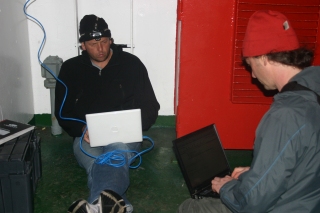I-TASC Antarctica Expedition 2006-07
Last night we sat in the bar and played cards. In the ship’s bar there are pictures of all the famous Antarctic voyages and landmarks. Mount Erebus exploding, the Endurance being crushed. For the first time, I feel a direct sense of where we are going, I feel a real sense of Antarctica as being a part of the world, whereas before, it was always somehow on the periphery to me. Now that I am here, I feel a strong connection, much stronger than I have felt before. As we are entering the geography of Antarctica, I feel Antarctica growing in my consciousness.
The icebergs are now only occasionally seen on the horizon and the pack ice surrounds us. Last night we played cards in the ship’s bar until late and then about 1am ventured out onto the front of the ship. It was clear light outside and it felt very much like we had entered a twilight zone. The ship came upon several large fields of pack ice while we were there and cut its way through. The ship usually slows to half speed within about 500m of the pack and then maintains a constant speed. The ship occasionally bumps up and down, similar to the shudders experienced when flying through air pockets, but usually the motion is smooth. In particularly thick ice, the ship stops completely. When this happens the ice broken by the bow cracks and turns by itself, tumbling in the water with eddies and currents as if there is a strong natural spring located beneath it. After a few minutes the boat then pushes forward again.
Often there are penguins and seals on the ice as we cut a path. The penguins usually run away when we get close, while the seals look lazily at us. Earlier we saw our first Emperor Penguin standing by itself on a lonely field of ice. It looked very solemn as it stood motionless with its back to us.
We filmed a lot of the ship’s movements through the pack and I took a lot of photos, but it’s hard to capture a feeling of this amazing contest between the boat and the ice. Watching a passage of broken ice open up in front of the bow, and marking a line that the boat then proceeds through, is a strange but beautiful sight that does not translate well to a still image or even video. We did manage to record some nice sound with two contact microphones attached to the hull. The cracking and hissing of the ice is clear in the recordings and I hope to use this sound in some short 1 minute audio docos I am working on.
Apparently we reach Neumayer today or early tomorrow morning. In preparation, we had a helicopter briefing and weigh-in. It is similar to the safety briefings given on commercial aircraft but perhaps a little more information as the safety equipment on board is a little more sophisticated. The chopper guys we have been seeing everyday and having the occasional drink with will now come to the fore and it looks like they are getting excited about finally doing what they came here to do. We are allowed a small bag on board for our flight to SANAE, which must contain enough to keep us going for three days while we wait for the rest of the equipment to arrive over land by the large caterpillar tractors.. I hope we can meet with I-TASC during the day and establish a recording protocol to reduce unwanted talking or bumping noises etc in the recordings.
 Today we slept late and worked only a little together as the I-TASC crew. It was a day off as it is Sunday. I passed the ship’s bar and TV lounge before lunch to see a small group of 7 or 8 people using the space as a makeshift church. During the afternoon, I read more about Shackleton’s amazing journey in his own words. Unbelievable. They seemed to survive for almost 18 months with little more than we would throw away in a week. I learned some Dutch a bit later then met the crew for dinner. After dinner, we met with Pierre and tried getting connected to the net via a BGAN terminal. We squatted on a high deck and tried to find the satellite in the dark, windy and cold night. We soon had a good connection and we were able to put up the Interpolar and I-TASC websites easily.
Today we slept late and worked only a little together as the I-TASC crew. It was a day off as it is Sunday. I passed the ship’s bar and TV lounge before lunch to see a small group of 7 or 8 people using the space as a makeshift church. During the afternoon, I read more about Shackleton’s amazing journey in his own words. Unbelievable. They seemed to survive for almost 18 months with little more than we would throw away in a week. I learned some Dutch a bit later then met the crew for dinner. After dinner, we met with Pierre and tried getting connected to the net via a BGAN terminal. We squatted on a high deck and tried to find the satellite in the dark, windy and cold night. We soon had a good connection and we were able to put up the Interpolar and I-TASC websites easily.